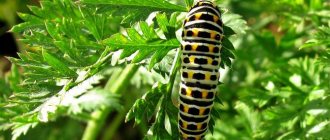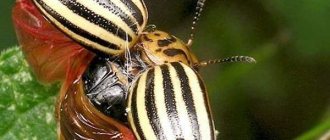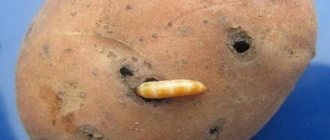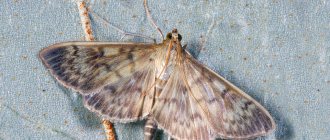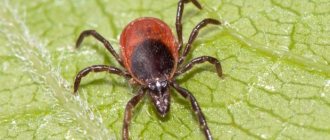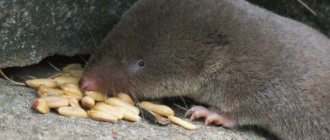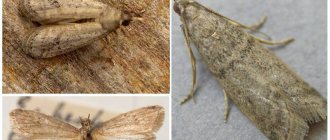What are the threats from insects?
Nature never ceases to amaze people with the wonders of flora and fauna. Not only are beetles sometimes very unpleasant-looking, but they can also be deadly to others. How the threat manifests itself:
- insects become carriers of infection;
- the creature poisons the blood of the victim upon close contact.
The science of entomology deals with the study of insects. The individuals themselves were called “insects”, thanks to Carl Linnaeus, the author of the animal classification system.
Ghost Mantis
Another amazing praying mantis. It is usually dark brown in color, but can also be sandy, light brown or even green. Its body resembles a dead, dried leaf, which helps it camouflage itself among fallen leaves in its natural habitat - the forests of Madagascar and Africa.
Phyllocrania paradoxa
Thanks to its amazing camouflage, the ghost mantis, sitting in ambush and waiting for the approach of prey, itself remains invisible to predators, such as insectivorous birds.
This is a small species, its length is about 5 cm. Females are larger and heavier than males.
Sometimes ghost mantises become frightened of their potential prey. Thus, adult males often run away from what they think is an insect that is too large, instead of attacking. This species is not as strong as some others, so its victims are mainly small insects.
The most terrible caterpillar in the world
Nature has endowed the large harpy, a butterfly in the caterpillar stage, with an unusual appearance designed to scare away enemies. To survive in a world of predators, the caterpillar freezes, becoming invisible among the lush greenery. Characteristics of the forest inhabitant of North America, Europe and Siberia:
- the individual remains at the caterpillar stage from July to September;
- The body length of an adult animal reaches 6 cm;
- the back of the green creature is decorated with a purple diamond, the sides are decorated with white spots;
- the end of the body is equipped with a fork-shaped outgrowth, which rises in case of danger;
- The head of the future insect is crowned with two eye spots, and underneath them is a gaping mouth.
The strange facial expressions of the individual, capable of imitating more dangerous insects, are intended to scare away predators, and the semblance of a “face” looks simply terrifying. If you touch the most terrible caterpillar in the world of insects, its “face” will turn towards you. If your attack continues, you'll be shot with formic acid from the little horns adorning the creepy creature's back.
Giant weta
The giant weta has the strangest appearance among the representatives of this top. If they walked on their hind legs, they could easily be confused with the coffee-loving worms from Men in Black. In reality, wetas are arthropod orthoptera creatures that live in New Zealand. These giants reach 7 centimeters in length and can weigh about 70 grams. By the way, wetes are one of the heaviest insects inhabiting the Earth. Fortunately, they are found mainly in forests and are nocturnal. They feed on plants, fruits and - very rarely - other insects. Even though they live in trees, wetes descend to the ground to lay their young.
The strangest creature
A terrible insect from the world of cicadas is called the Brazilian humpback. The ugliness of the creature is frightening due to the strange structure of the head with bumpy growths resembling antennas. The balls, which look like huge eyes, are actually chitinous structures designed for camouflage on plants. Due to its small dimensions (body length about 2 cm), this native of the Brazilian jungle is difficult to see with the naked eye.
It is interesting that the terrible insect has long been considered a figment of the imagination of the German sculptor who painted the insect. Then the unusual creature was photographed in the tropical world of Brazil.
Malaysian orchid mantis
The orchid mantis is a very beautiful species native to the Asian rainforests. Its color can range from pure white to yellow and pink. An adult female is approximately 6-7 cm long, while the male is only about 2.5 cm. The legs of this insect resemble flower petals, which, coupled with its color, allows it to successfully camouflage itself among orchid flowers.
The photo below perfectly demonstrates how a praying mantis hides in a flower.
Because of its mesmerizing color, the orchid mantis is very popular among lovers of exotic insects.
Hymenopus coronatus
The insect with the most terrible name
One of the world's largest insects is called the Devil's Flower. The large mantis is one of the most predatory species of insects, capable of waiting for its prey for a long time during a hunt, without moving. What features has nature awarded to the terrible inhabitant of East Africa:
- body length of the male is 11 cm, the female grows up to 14 cm;
- the wingspan of insects of both sexes reaches 16 cm;
- the slender body of the praying mantis is equipped with very long limbs;
- the triangular head of the insect is crowned with “devilish” horns.
A creepy insect with an awkward appearance is not dangerous to humans, since it does not have poisonous glands, but its aggressive behavior and scary appearance may well frighten. The unusual creature is called the Devil's Flower for the ability of females to grow real orchid petals on their bodies, which the strange individual tries to camouflage as.
Cockroach - rhinoceros
Lives in Australia. The second name is giant burrowing cockroach . In appearance it looks more like a beetle, but belongs to the cockroach family. This is the heaviest type of cockroach on the planet. Its weight is about 35 grams. But, despite their rather disgusting appearance, some connoisseurs keep them at home, in terrariums. They are clean and do not have a nasty smell. Moreover, they live up to 10 years . Favorite food: fallen tree leaves.
The most terrible moth in the world
It is not the moth itself, a native of Denmark, that inspires fear, but its formidable caterpillar, called the Shy Moth. From a distance, the bright yellow caterpillar looks like a porcupine or a sponge due to the islands of spiny hair covering its 50 mm body. Up close, the caterpillar is frightening with its double row of jaws, and with the arrival of autumn it becomes a harmless pupa.
Infestations of the world's worst moth are causing significant damage to Denmark's beech forests. For humans, contact with caterpillar hairs results in the appearance of an allergic rash, which is very painful.
DARKER
-Are you afraid of insects?
- Afraid…
- Why?
- Well, they have all these antennae... And also paws.
- So what? You also have a mustache. And paws.
Overheard Conversation
Will insects take over the world?
Insects are like us. They have limbs, "arms" and "legs". They breathe air, eat food, have children, spend time with their own kind, are born and die. Like us, they are alive.
Insects are not like us. Their eyes without pupils do not express anything understandable to us. How often in horror films does the object of fear become a creature who, by our standards, has something wrong with his eyes: either there are none at all, or there are a lot of them? The eyes of a fly are divided into equal parts without a “compositional center” (that is, without a pupil), they are too large, they burn with red or green fire. Anyone with eyes like that should never be trusted. And we don't trust.
We - at least so it is commonly believed - are guided by reason. But insects are ruled by instincts. They do not know love, hate, compassion and fear. They are no strangers to cannibalism, and they can eat not only their relatives, but also themselves. They do not enjoy life and are not afraid of death.
Perhaps it is permissible to generally doubt whether insects have a feeling comparable to our suffering. A red cockroach, having injured its leg during molting, willingly sucks the blood flowing from the wound and often, not limiting itself to a licked drop, bites into its own flesh. If the body of a bee, while she is sucking sugared water, is carefully and quickly cut in two with sharp scissors, she will not interrupt her meal. Moreover, in this case, the pleasure from eating, if only the insect is allowed to experience pleasure, will last much longer: the bee now cannot fill its crop with food. Everything that she sucks in with her proboscis immediately flows out from behind the cut in a thin, sugary stream. Soon the bee finds herself in the middle of a puddle of sweet juice. Finally, exhausted from continuous sucking, she collapses. (From the book “Ten Little Uninvited Guests” by Austrian entomologist Karl Frisch)
It seems that, in human terms, they feel nothing at all. Well, according to your own insect concepts? “The thread was stretched at the five ends, and the insect did not want to live. It doesn’t want to breathe, however, no one can know its intentions,” wrote Anri Volkhonsky and Alexey Khvostenko in the mid-20th century. And modern entomological scientists agree with them: we don’t even suspect what’s “on the mind” of insects.
It will be very difficult for you and me to understand what they feel, because there is a very large distance between our senses and their senses. I don’t want to say “abyss”, because the stimuli are approximately the same, but their processing and perception, apparently, have nothing in common with ours. Let's say your eyes focus. I look at you, I see the details of your face, but what is behind you is out of focus for me. The insect has no focus. The closer he gets, the clearer he can see. Therefore, when a mosquito sees you from afar, you are some kind of vague spot for it, although it smells delicious. But when he dives, he sees better and better. When he sits on your hand, he sees the smallest details of your skin. All the pores, all the hairs. That is, he examines your skin as if under a microscope, finds the right point and sticks his jaw apparatus directly into your vessel. How he finds this vessel is still not really clear. We see a vein, but the mosquito does not aim at the vein; it feeds from thinner vessels. How does he find it, with what feeling? Who knows? Drug addicts would probably give everything for this information: how to get into a vein when they are no longer there. (From an interview with Vladimir Dmitrievich Ivanov, head of the Department of Entomology at St. Petersburg State University)
From here it’s easy to move on to conspiracy theories - insects are aliens from outer space! For now they are biding their time, but one day they will certainly take over the world. Why not? It is known that insects lived on Earth long before the first human ancestors. Moreover, some - cockroaches, for example - have hardly changed since then. It is no secret that even in a hypothetical post-apocalypse, it will be much easier for “insects” to survive. Even nuclear weapons are not that scary for them. They are also very small, fast, and nimble. And there are many, many more of them...
“A housefly lays about a hundred eggs at a time, and over a thousand during its life. If larvae hatched from all these eggs and, developing, gave birth to new flies, which, in turn, multiplied in the same way, then one couple of our friends would produce 500 thousand in the second generation, 250 million in the third, 125 billion in the fourth flies,” Frisch fearlessly calculates.
If flies become more responsible parents, then soon there will be no one left on Earth except hungry fly larvae that have covered the planet with a thick layer. But these are only flies - how many other insects are there that are no less prolific?
So, it seems that the takeover of the world has been postponed for now: it would be too easy to carry out if desired. If so, then you can breathe out, right? You've stopped being afraid, haven't you?
God with the head of a beetle
Studying human instincts, scientists have found that six-month-old babies experience fear when they see spiders. And although spiders are not insects, they belong to the same class of creatures - arthropods. A class where everyone has six (insects), eight (arachnids), or even more (centipedes and crustaceans) limbs. These limbs move randomly, reminiscent of primordial chthonic chaos. And their owners can really bite like that - and for some reason the babies know about this, although they have never met them yet.
An adult also nervously waves it away or tries to crush the insect, even if he knows that, say, a longhorned beetle is not a predator at all and the worst thing it can do if it senses danger is to start creaking menacingly. "But what if? - instinct worries, pushing his arm. “Isn’t it enough?”
Instinct has no time to figure it out: by the time you figure out whether it’s a barbel or a “biter,” you can throw away your skates. But let’s say you can try to “pacify” the instinct. The ancient Egyptians somehow managed it, among whom the scarab beetle was considered one of the most revered animals. And the god Khepri (aka Khepera) with the head of a beetle (or a beetle instead of a head) was considered a symbol of dawn, the origin of life - almost the beginning of all beginnings.
The ancients held curious views regarding scarabs; they believed that female scarabs did not exist, and “scarab” meant “only,” that is, a creature that reproduces itself without the participation of a female. The beetle, having formed a dung ball, rolls it from east to west and, having dug a hole, hides the ball in it for twenty-eight days. On the twenty-ninth day, he digs up a ball, throws it into the water, and scarabs come out of it. The fact that the scarab flies at the hottest time of the day, as well as the shape of the balls with larvae, made it possible to identify the insect with the sun. The invisible power of the god Khepera made the sun roll across the sky, and the scarab rolling dung balls received the name “kheper”, that is, “the one that rolls”. The sun carries the germs of life, so a scarab ball containing beetle larvae was identified with the sun as a creature that reproduces life in a special way. And since the god Khepera in ancient times was considered the god of resurrection, the scarab, identified with him, turned into a symbol of the god and became a sign of resurrection. The dead human body also contains in some way the germ of life, that is, the germ of the spiritual body, which comes into being through the prayers and ceremonies performed at the time of burial. This is the identity of the ball with larvae and the dead body. The Egyptians believed that, just as an insect gives life to its larvae contained in a ball, a scarab figurine - the symbol of the god Khepera - gives life to a dead body, into which this figurine is inserted along with the “words of power.” (Budge Wallis, “The Magic of Ancient Egypt. The Secret of the Book of the Dead”)
And it’s not just the Egyptians who are “so smart”: according to Sergei Alkin, associate professor of the Department of Archeology and Ethnography at NSU, in the Neolithic era insects and their larvae were identified with the souls of the dead. This is confirmed by archaeological finds: in ancient times, in the territory of modern East Asia, there was a real cult of insects.
What happened? Why is it that today no one is filled with awe at the sight of beetles, which is why, in essence, everyone loses: both we, deprived of goodness, and they, whom we mercilessly crush?
It seems that “many knowledge - many sorrows”: with the development of science, we got to know insects better. And this made them fear them much more.
Drawing of a “giant” flea from the book Micrographia (“Micrography”) by Robert Hooke, 1665
Monster flea
Just five hundred years ago, most insects were inaccessible to human sight. Well, someone jumps, well, a little black dot bites. Unpleasant, of course, but quite tolerable.
Until the “masters of the microscope,” scientists like Robert Hooke and Antonie van Leeuwenhoek, looked at these dots in their microscopes. The microworld that scientists discovered was soon seen by others - something was sketched, printed, and with the development of photography, filmed. So it was revealed to earthlings that real monsters were jumping and crawling literally two steps away.
Sometimes progress develops faster than the human psyche - and this creates problems. In the 19th century, earthlings as a whole were not ready to accept the body of revolutionary ideas that refuted the divine plan. And since then, in the words of Jean-Paul Sartre, each of us has a God-sized hole in our souls and everyone fills it as best they can.
A similar thing with the microcosm: in all its glory, it did not fit into people’s ideas about harmony, about what a living being should look like. And the worst thing is that he was not invented by a mad writer of gothic prose. This is reality (“the film is based on real events”), it is alive, the same as us... and not at all the same.
A flea eats, drinks, sleeps, reproduces, is born and dies - that means it is part of life. And if so, then it is part of us, because we also have a direct relationship to this life. And since the flea is part of us, then we too... no, it’s better not to think about it.
The development of a flea from egg to adult - from the book Opera omnia s by Antonie van Leeuwenhoek. Arcana naturae etc (“Secrets of nature discovered by Anthony Leeuwenhoek with the help of microscopes”), 1695
The instinctive fear of arthropods as a carrier of danger, built in by the “developers,” was superimposed with “patch 1.1” - an irrational horror from the category of “what are you”, “how to unsee this” and “my life will not be the same”. The man looked into the compound eyes, which flashed opposite him like a kaleidoscope of lights. And he didn’t like what he saw in them.
At the heart of this feeling, however, fear is not at all new: horror of the unusual, of renewal as such - in a word, what in a fit of misanthropy can be called philistine inertia. Strife, religious wars, ideological squabbles, online trolling - the nature of these phenomena is the same as the desire to crush a bug that has crawled into the house. For some reason you don’t look very much like me - shouldn’t I grind you into powder before you do something similar to me? And if it turns out that there was no danger in the “other” - nothing, the main thing is to play it safe. And, by the way, remember how many films you know about aliens, where the authorities attack guests from outer space from the first minutes, without understanding whether they are good or evil, “otherwise you never know”? And that's all about that too.
"Other"
Of course, if there are “philistines”, there must also be “smart people” in contrast to them. In 1822, the dying Ernst Theodor Amadeus Hoffmann finished the story “The Lord of the Fleas.” Closer to its ending, young Rose, a romantic symbol of purity, kindness and generally all the best, comes face to face with the ruler. At first, the sight of a huge flea, beyond the norm, frightens her, but “the master flea looked at her with such intelligent, friendly eyes” that her fears immediately receded.
The fleas, ruled by the ruler, turn out, despite their unattractive appearance from a human point of view, to be a glorious people of free jumpers with knowledge that upright “bipeds” could never even dream of. The wise, virtuous master flea becomes a guardian angel for Peregrinus Tys, who humbled his mistrust before the miniature plexus of antennae and legs, which he did not regret. And the doubts that Tis had, overheard by the lord of the fleas, were always crushed by the master with his characteristic intelligence and tact:
You marvel at the intelligence and strength of spirit of a tiny, usually despised insect, and this proves - not to be said in anger - at least the insufficiency of your scientific education. I would advise you to read what the Greek philosopher Philo says about the thinking and self-controlled soul of animals, or at least in the treatise of Hieronymus Rorarius “Quod animalia bruta ratione utantur melius homine” [“Why irrational living beings use reason better than people” ] or in his “Oratio pro muribus” [“Speech in defense of mice”]. You should also know what Lipsius and the great Leibniz thought about the mental faculties of animals, or what the learned and wise Rabbi Maimonides said about the soul of animals. It is unlikely that then you would attribute my intelligence to the fact that I am some kind of evil demon, and you would certainly not begin to measure the spiritual power of the mind by the physical dimensions of the body. I think that in the end you are inclined to the witty view of the Spanish doctor Gomez Pereira, who sees in animals only skillfully made machines without the ability to think, without free will, moving involuntarily, automatically. But no! I do not admit that you can reach such vulgarity, my good master Peregrinus Tys, and I am firmly convinced that, thanks to my insignificant person, you have long since improved your view of things.
Illustration for one of the first editions of “The Lord of the Fleas” by Hoffmann, 1826
“Small does not mean bad, and “scary” and beauty are relative concepts” - a discovery at the level of “blacks are people too.” And yet, Hoffmann, with his clearly readable call not to cut fleas off one's shoulder, found himself in the minority. 90 years later, Franz Kafka writes “The Metamorphosis” - an outstanding cultural and entomological text, where the author can hardly be suspected of insectophilia. In one of the rooms of the Samsa family's house, an indescribable horror settled in ("It cannot be drawn even in the background..." - Kafka warned the illustrator of the first edition). And his name is insect.
It's hard to suspect, but we'll try. Didn’t Kafka have a desire to once again emphasize the otherness, the tragic isolation of his character, making him not just anyone, but a “bug”? Isn't it true that Gregor Samsa, after his transformation, is the only hero of the text who evokes sympathy from beginning to end? Having become a “monster”, jumping out of the cage of social norms, internally he becomes better than he was. But outwardly, Gregor ceases to correspond to at least some generally accepted standards. “Transformation” is about the fact that if you are “different,” you will receive a fatal blow from your own father with an apple on your delicate chitinous back. Our “correct” world, it is not for the disabled, freaks, homosexuals, niggas, transvestites, beggars, pensioners, whores, flies, bedbugs, cockroaches, beetles... We have our own very strict rules here.
If a person is tolerant of “others,” then for the majority he himself is “different.” If your friend is calm about the existence of gays, how soon will you start looking askance in his direction? And if he speaks sympathetically about mosquitoes and wasps, shouldn’t you expect a poisonous bite from him when you turn your back?
Cover of the first edition of Kafka's Metamorphosis, 1916
In the 12th-century Japanese short story “The Caterpillar Lover” from the collection Tsutsumi Chunagon Monogatari (Tales of Middle State Councilor Tsutsumi), the heroine Himegimi is trolled for preferring caterpillars to butterflies and devoting all her free time to observing them, reasoning: “What for the monstrous stupidity of loving only flowers and butterflies! A real person comprehends the essence of things with an unprejudiced soul.”
And so Himegimi collected a myriad of disgusting insects and put them in baskets and boxes. And all in order to see what will come of them. Himegimi especially admired the hairy caterpillars for their thoughtfulness. Combing her hair back, she looked at the caterpillars on her palm day and night. (From the collection “Japanese Short Story”, compiled by A. N. Meshcheryakov, 2003)
Everyone is trolling the girl, and it’s clear that whoever stands up will be trolled even more. Something like today's school bullying. And it would hardly be better today: both for its era and for our Himegimi are completely out of trend. It seems that even with a “thinking” view of insects, priority is still given to the position of Aristotle, described by him in the “History of Animals”: one should study “beetles” only in order to, starting with small ones, gradually learn about “higher” creatures, where at the very top, naturally, is a person.
Of course, over the years something has changed. In 1857, the French historian and naturalist, the author of the term “Renaissance,” Jules Michelet wrote L'insecte. Insect researcher Hugh Raffles characterizes this untranslated text as follows:
He is not convinced by the superiority of the butterfly, the thesis that it is the most captivating of animals - the realization of the potential of the caterpillar, just as an adult is considered to be the realization of the potential (for better or worse) of a child. In part, this thesis is born of Darwinian teleology: the emphasis on reproduction as the goal of existence confirms that the sexually mature form of the animal is the only one worth taking into account. Part of the thesis is more generally related to evolution: the logic of immaturity and development, the progression through ever grander, more highly developed stages to the most highly developed, to the most ideal states - an idea that has deeply permeated political, cultural and private life since the late nineteenth century, despite because our experience of political, cultural and private life tells us categorically that there are no guarantees of purposeful progress.
However, these and similar judgments have become entrenched on the periphery. In general, nine centuries since the dear Himegimi died (it is possible that, having shed her unnecessary wings and become a fleecy emerald beauty, she ended up in a better world), today entomology and its priests are still in a marginal position. A young caddisfly researcher, Mikhail Valuysky, claims that new acquaintances, having learned about his research, react, although without fear, but do not show much friendliness:
Usually they say: “Uh, insects. Strange. Caddis flies? Who are they anyway? I say: “Yes, that’s the topic. I'm such a strange guy. Our entire department is so strange.” Usually this is where people lag behind. They write somewhere in their head: “Yeah, this is a strange guy, he’s doing something that we don’t understand.” This is where it all ends. Among university colleagues from other departments, the reaction is also something like this: “Caddis flies? I wonder what you are publishing about them there?
Fear from instinct, fear from reason, fear of what is not like us, fear of those who associate with those who are not like us, fear of relating to those who are unlike us... It seems that there is quite a lot. Do you think entomologists themselves aren’t afraid of insects? And how! Hugh Raffles wrote down his thoughts while viewing the exhibition at the Montreal Insectarium:
How strange it is that we look at insects as beautiful objects, that after death they become beautiful objects, when in life, running along wooden floorboards, hiding in corners and under benches, getting tangled in our hair and climbing up our collars, crawling into our sleeves ... just imagine the chaos that would reign if they came back to life. Even in this museum we would be overcome by an unconscious impulse to rush in and crush them.
Yes, it would be an exciting picture: a respected insect lover, the author of the thick “Insectopedia”, in which he talks about insects with lively tenderness and fanatic interest, forgetting everything and trampling on stick insects and mantises. So what to do? You won’t start screaming, trying to overcome the squeaking and buzzing: hush, hush, guys, let’s calm down and talk a little. Who would dare to speak to the raging masses? And anyway, how to talk to them?
Prospects for dialogue
But, it seems, insects could tell us something if we had the opportunity to engage in conversation or at least correspondence with them. The same Hugh Raffles thought about this, in the same insectarium:
If you watch how people move from display case to display case in a museum hall, you will immediately notice that many of these “objects” have powerful “psychic powers”. This is evident from the way everyone - including me - maneuvers between the exhibits, from the way we all move along the rows: slightly timidly, and then suddenly stopping, and sometimes backing away sharply. It’s somehow strange that we behave this way, because the insect is not only locked in a plexiglass box, but now does not pose the slightest physical danger, if it did at all before. It feels as if these insects—along with their beauty—penetrate some secret recesses of our soul, and in response, something seemingly taboo draws us to insects.
Repulsive and attractive, dangerous and beautiful, alluring and forbidden - insects seem to be located on the border of two worlds. The one in which we exist and in which they are similar to us, and the other, about which we have not the slightest idea. Where a wasp cut in half continues to gorge itself on honey, and a cockroach happily eats its own legs.
They are like guardians: the inhabitant of the border can pass through it, right? Remember how Ivan Tsarevich, having managed to turn the hut on chicken legs to himself, managed to win over the owner, the dead-alive “border guard” at the border of dimensions? And he gets a chance to touch the transcendental, to visit the world of spirits, which symbolizes the Far Far Away Kingdom. (It may be noted that entities capable of introducing the transcendental in the range from Baba Yaga to Andy Warhol rarely have canonical beauty. But if you overcome the initial rejection, the experience gained in the end will be invaluable).
Insects could take us to the same kind of kingdom. No, not into the world of spirits, but into the world of the unknown, where, perhaps, one is allowed to go beyond the boundaries of personal and even human subjectivity. A world where you are a person or an insect - there is no longer a difference, because there are no concepts and meanings given by man and human.
And this may turn out to be truly both terrible and beautiful - much more terrible and beautiful than any of the brightest and most predatory beetles. But for this we need to move from continuous attacks and defenses to dialogue. And here again - how to do this? The head of the Department of Entomology at St. Petersburg State University is not ready to give hope on this score. But he says there are prospects.
The language of an insect is a set of signals that are completely alien to us. Somewhere butterflies are flying and communicating with each other. Their dialogue proceeds chemically. That is, both their questions and their answers are chemical. We can decipher these chemicals, but we don't understand what they are about. We see that there is a dialogue going on, but we do not understand what it is about. We can put some insects in a jar, and if we take a sample of the air, we see that there are some repeating sets of volatile substances there. We know where they are secreted from, from what glands, these glands can be found, but we do not understand what this conversation is about. The male and female have glands, they talk about something chemically. And we see their complex behavior against this background, when several males, for example, fly to a female, sit next to her, and do nothing. The female had clearly invited them, perhaps to mate. They try to come to an agreement, but they can’t, I witnessed this. We sat and scattered. Dialogue with insects is possible in the future when we understand what signals they can correctly interpret and understand. It will be possible to tell them something, to achieve something from them. I worked on this issue before, and now too. Work continues.
Antennae and paws
But rely on scientists, and don’t spit in the well yourself. Start simple - with acceptance (first stage). Insects are all around us, and there is nothing we can do about it. Your apartment is almost certainly inhabited by silverfish or harvestmen. The microclimate of our homes suits them; they eat pieces of paper, dust and other garbage we produce in abundance. They are very small, there are not many of them, in the light they are extremely rarely visible and do not pose any danger to humans.
At the same time, on the Internet you will find a lot of articles from the series “how to remove silverfish.” But why, for what? Because they have antennae and legs? So, after all, many of you also have antennae, and almost all of them have paws. So what now?
It’s scary, unpleasant, so you want to get rid of it - that’s understandable, of course. But, as the picture from the depressive segment of the Internet says, “it’s so easy to be sad, but just work hard.” The articles don't lie: it really isn't that difficult to kill silverfish. But why not work hard? Not even for myself - for the collective earthly future.
Let's assume that in the future scientists will establish a dialogue with insects - but what if they don't want to talk to us? What can you talk about with those who destroy them, small fragile creatures? Not just the “biting” and “evil” ones, but everyone in a row, sometimes, like other children, even for fun?
Of course, you can tell them: “We are afraid.” And then the insects will ask in surprise: “Why be afraid of us?” And here, of course, you can explain to them about instincts, and about otherness, and about this, and about the other... But all the same, no matter how you look at it, it’s all somehow awkward and uncomfortable for us.
Support DARKER!
It is important! We need your help. Become a DARKER sponsor and get exclusive early access to content from new issues and more!
We are VKontakte
Subscribe!
Our Instagram
Subscribe!
Terrifying butterflies
Satin peacock eye
It can be called the most terrible butterfly in the world, frightening in its appearance. The resident of the subtropics is quite large for this type of insect, with a wingspan of up to 25-28 cm. The color of the wings of the world's largest butterflies is frightening in its analogy with the head of a snake, ready to attack its prey. The butterfly was nicknamed a cobra for the unusual color of its wings, but the insects are grown to produce silk.
Imperial Tailed
An unusual butterfly that lives in the Australian wildlife world has nothing wrong with its appearance. But with an individual at the caterpillar stage, things are worse. The most terrible part of the caterpillar's body is its head, framed by four terrifying horns. The living structure resembles a dinosaur shell.
Peacock-eye from the genus Lonomy
The most terrible insect in the world can be called the creature Lonomiya, which lives in South America. Nature did not provide the caterpillar of the butterfly of the same name with either a chitinous shell, legs or wings. A person should be wary of an individual that can perfectly camouflage itself to its environment. If Lonomiya's poison enters the bloodstream, even after a simple touch, it will result in a brain hemorrhage.
7) Rat flea
One of the most dangerous types of insects are rat fleas. They are the main parasites and carriers of terrible diseases, including the plague. They live on the bodies of rats and gerbils in tropical and subtropical climates. Externally, the rat flea is 2-3 mm long. In appearance, rat fleas are no different from their other species. They mainly reproduce and feed off of the rat's body. A flea bite for a person is accompanied by severe itching, redness, swelling and suppuration of the wound. An allergic reaction also often occurs. A repeated bite of a rat flea entails the following consequences: long-term headache, inflamed lymph nodes and the formation of ulcers on the body. In addition to the symptoms of the bite, fatal diseases also develop: rat typhus, plague bacillus, rat chain worm, salmonellosis, brucellosis, anthrax, tularemia, plague and encephalitis.
The most poisonous centipede
The giant scolopendra is considered not only the most terrible insect, but also the largest in the world. The nature of South America and the islands of Jamaica has endowed the vile creature with a long body (up to 35 cm), covered with brown segments (up to 23 pieces), each of which has a pair of bright yellow legs. The front pair of legs turned out to be a mouth and consist of jaws with poisonous claws.
If you happen to encounter an Amazonian scolopendra, keep in mind that the insect is very aggressive. Grabs its enemy with all 46 legs to inject poison. But the poison is not fatal for people, only for small animals.
Giant water bugs
You can rejoice in the harsh Russian climate, if only because it does not allow some animals to exist in our country. It is unlikely that you would like meeting a giant water bug that lives in the reservoirs of the tropics of North and South America, as well as in eastern Asia. Some of the individuals of this species can reach 15 centimeters in length. These insects are excellent predators; their front legs have hooks with which they can capture and hold prey, such as a frog. Outwardly, they are not much different from ordinary bedbugs until the mating season begins. At this time, females lay eggs on the backs of males, which they are required to bear. It looks disgusting and unnatural. If you don’t know about the existence of these bugs, then when you meet one, you might think that you saw an alien creature.
Invasion of poisonous ants
- After meeting on the paths of the tropics with the largest ant in the world, a very painful memory remains. The insect was nicknamed the bullet ant for its longest sting (3.5 mm), which is longer than the body of the insect itself.
- The harvester ant from America has the most toxic poison in the world. When attacking a victim, it grabs it with its pincers to inject a copious portion of poison. The pheromones released in this case become a signal for relatives.
- American Siafu ants managed to occupy even the tropics of Asia. The bite of the most terrifying-looking insect can be fatal, especially for the youngest or oldest people.
Praying Mantis “Spiky Flower”
It is a tiny (less than 4 cm) insect with a spiny underbelly and fascinating wing designs. The “eyes” on its wings resemble the number 9 and serve to scare away predators. However, these mantises themselves are vicious predators. Their camouflage is so good that some insects, mistaking them for flowers, land on them, which naturally makes them easy prey for the “Prickly Flower”. This species is found in South Africa.
The photo below shows the “Prickly Flower” mantis in all its glory.
Pseudocreobotra wahlbergi
Like most species of mantis, the Thorn Flower is a cannibal. He will eat anything that moves as long as it is the right size. And if a small praying mantis gets in his way, he will eat him without hesitation.
Threatening flies
- The venom of the world's most feared insect, the tsetse fly, poses a mortal threat to all mammals. Although the venom is free of toxins, the insect's sting injects parasites, the causative agents of sleeping sickness, into the enemy.
- The scorpion fly is a strange victim of genetic mutation. The world's oldest insect looks like both a scorpion and a wasp, with the stinger being the genitals of a creepy hybrid.
Urchin fish
Hedgehog fish
Hedgehog fish is common in almost all tropical seas and coral reefs. This is a half-meter fish, capable of inflating in case of danger and taking the shape of a ball. Its entire body is strewn with large sharp needles, which allows the hedgehog fish to protect itself from predators. As long as the hedgehog fish is not bloated, it seems harmless. Often even sharks and barracudas succumb to this gentle appearance and end their lives by choking on a urchin fish. Fishermen often find dead sharks with bloated urchinfish stuck in their throats.
The needles of these fish pose a particular danger to those who like to swim among coral reefs.
The most terrible among spiders
This category includes Salpuga, a giant camel spider. The inhabitant of the countries of the East, whose length is 15 cm, makes chirping sounds, and the speed of movement of the fastest spider in the world reaches 16 km per hour. The desert dweller with strong jaws can bite, but its venom is not fatal and not particularly painful.
Phrynes, which are called whip scorpions, are among the most terrible spiders in the world. Threatening-looking tropical insects come in a variety of sizes, but are not dangerous to humans.
Common earwig
The insect is found in Europe, as well as in Russia. Only about two centimeters long. The second name is two-tailed, it received because of the forked tail at the end of the body. It does not pose a great danger to humans, as it rarely bites, mainly for defense. Eats both animal and plant foods.
By the way, this insect has been disliked since ancient times. From there came the belief that an earwig can get into a person’s ear and deprive him of his hearing by damaging his eardrum, but in fact this is just a myth.
The world's best concealer
The title of the best camouflage was rightfully won by the Stick insect - a giant insect called the “spiny stick”. You can meet the horror story in Australia or the USA, even in Russia. Nature rewarded the most terrible master of camouflage with a long body (12-20 cm) with stick-leaf legs.
The monster, covered with green spines, spends most of its time trying to blend in with the elements of its environment. When threatened, the insect takes a fighting pose, putting its limbs forward, which makes it look like a real scorpion. The stick insect repels predators by releasing a chemical whose aroma reminds humans of peanut butter.
crown of thorns starfish
Starfish
This is a bottom-dwelling marine animal that lives in coral reefs. The skin of the crown of thorns is studded with three-centimeter thorns, the ends of which are poisonous; Color varies from deep red to green and orange. The size of this starfish can reach 50 cm.
These are sedentary creatures that barely move along the bottom, but are very voracious. They especially love to eat corals, so they cause great harm to coral reefs. Reefs grow very slowly, and one crown of thorns can devour 13 square meters of reef per year. Multiply by the number of stars in these waters and you will understand the destructive effect these stars perform.
How does the crown of thorns feed? It spreads out on the coral, attaches itself to it, turns its stomach inside out, the size of which is equal to the size of a star, covers the coral with it and secretes gastric juice. The corals soften and turn into a liquid mass, which the star draws into itself.
The crown of thorns is also dangerous for humans. The prick of his needle is very painful and causes severe poisoning of the body.
Moloch
Moloch or “prickly devil” is a reptile native to Australia.
Its body is covered with small curved spines of varying sizes, the longest and most frequently located of which are on the upper part of the body. In case of danger, the lizard lowers its head low, and the spiny outgrowth in the cervical region forms a kind of “false head”, which distracts the predator’s attention from the real one. The resemblance of horns directed towards the attacking enemy creates the effect of demonstrative danger and aggressiveness of the moloch, which gives time and opportunity for the agile lizard to escape.
The thorns also provide the “household needs” of the “prickly devil”: through them, collected moisture in the form of dew and precipitation enters the reptile’s mouth through microscopic channels between the scales.
Violin Mantis
The violin mantis is another unique species. It got its name because the adult is a bit like a violin (the body is the soundboard of a violin, the head is the top of the violin, and the long and thin middle part is the neck of the violin). In nature, it lives in India and Sri Lanka.
The color of the violin mantis varies from light brown to dark brown. Nymphs have less pronounced camouflage than adults. Females reach a body length of 10 cm, males - about 9 cm.
This typical waiting predator specializes in catching flying insects. He can snatch a fly out of the air!
The ghost mantis is not at all aggressive and is easily spooked.
In contact with
Brazilian humpback
0 Source:
These are small insects whose distinctive feature is the most incredible shaped outgrowths located on the back. They can be in the form of horns, ridges, balls, spikes, horns, etc. These “structures” sometimes exceed the size of the humpback itself. Actually, because of them, this insect got its name. Meet the most unpleasant insects on our planet. Brazilian humpback or Bocydium globulare Evolution made the Brazilian humpback so ugly for a reason. The surreal appearance of the insect scares away predators. Quasi-bumps in the form of antennas, at the end of which there are balls similar to eyes, are actually chitinous layers that protect the humpback from attacks by predators. Yes, these are the harsh realities of the wild. The uglier and scarier you look, the more likely you are to survive.
3.


